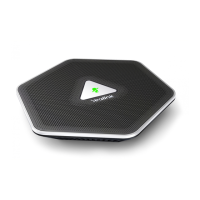Configuring Network
65
IPv6 Address Assignment Method
Supported IPv6 address assignment methods:
Manual Assignment: An IPv6 address and other configuration parameters (e.g., DNS
server) for the IP phone can be statically configured by an administrator.
Stateful DHCPv6: The Dynamic Host Configuration Protocol for IPv6 (DHCPv6) has been
standardized by the IETF through RFC 3315. DHCPv6 enables DHCP servers to pass
configuration parameters such as IPv6 network addresses to IPv6 nodes. It offers the
capability of automatic allocation of reusable network addresses and additional
configuration flexibility. This protocol is a stateful counterpart to “IPv6 Stateless Address
Autoconfiguration” (RFC 2462), and can be used separately or concurrently with the latter
to obtain configuration parameters.
How the IP phone obtains the IPv6 address and network settings?
The following table lists where the IP phone obtains the IPv6 address and other network
settings:
How the IP phone obtains the IPv6 address and network settings?
You have to manually configure the static IPv6 address and other network
settings.
The IP phone can obtain the IPv6 address and the other network settings via
DHCPv6.
IPv6 Network parameters need to be configured manually on the endpoints are described
below.
Configures the IP address mode.
Default: IPv4
Note: If you change this parameter,
the IP phone will reboot to make the
change take effect.
Remote Control
Web User Interface
Enables or disables the endpoint to
use manually configured IPv6
network settings.
Default: Disabled
Note: If you change this parameter,
the endpoint will reboot to make the
change take effect.
Remote Control
Web User Interface
Configures the IPv6 address
assigned to the endpoint.
Remote Control
Web User Interface

